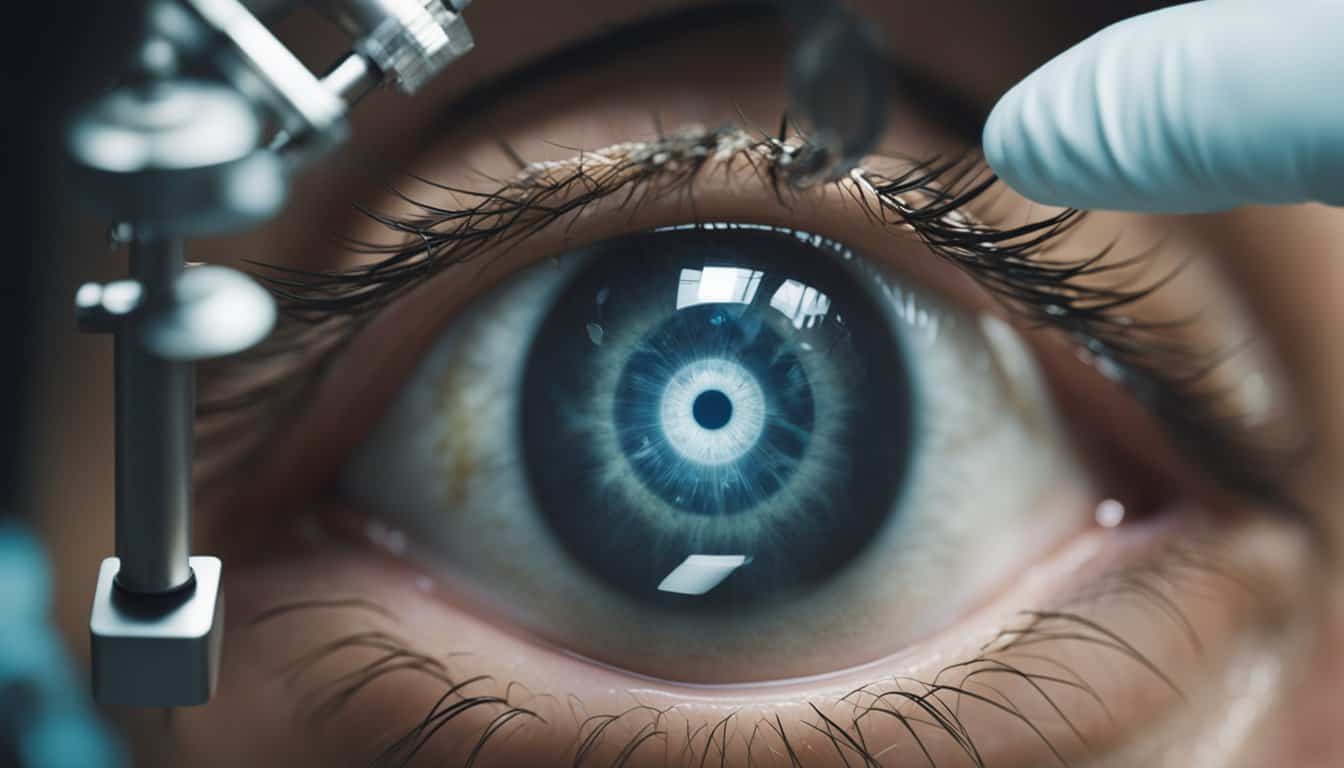If you’re experiencing vision problems, you may have heard of cataracts. Cataracts are a common condition, especially among older adults. They occur when the natural lens in your eye becomes cloudy, causing blurry or distorted vision. Fortunately, cataract surgery is a safe and effective treatment option that can help restore your vision.

If you’re considering cataract surgery in Singapore, it’s important to understand the procedure and what to expect. Cataract surgery involves removing the cloudy lens in your eye and replacing it with an artificial lens implant. There are several types of cataract surgery procedures available, including traditional cataract surgery and laser-assisted cataract surgery. Your surgeon will help determine which procedure is best for you based on your individual needs and preferences.
Key Takeaways
- Cataract surgery is a safe and effective treatment option for restoring vision.
- There are several types of cataract surgery procedures available, including traditional cataract surgery and laser-assisted cataract surgery.
- Your surgeon will help determine which procedure is best for you based on your individual needs and preferences.
Understanding Cataracts

If you are experiencing vision problems, you may be developing cataracts. Cataracts are a common eye condition that can cause blurry vision and difficulty seeing at night. In this section, we will help you understand what cataracts are, their symptoms, causes, and risk factors.
What Are Cataracts?
Cataracts are a clouding of the natural lens in your eye that can cause vision problems. The lens is normally clear and helps to focus light onto the retina at the back of your eye. However, as you age, the lens can become cloudy and less transparent, leading to cataracts.
Symptoms of Cataracts
The symptoms of cataracts can include blurry vision, difficulty seeing at night, sensitivity to light, and seeing halos around lights. You may also experience double vision in one eye or have trouble distinguishing colors.
Causes and Risk Factors
While aging is the most common cause of cataracts, other risk factors can include diabetes, smoking, and a family history of cataracts. Cataracts can also develop as a result of eye injuries or exposure to certain medications or radiation.
If you have cataracts, the condition will generally worsen over time. However, the rate of progression can vary from person to person. If you are experiencing vision problems, it is important to see an eye doctor for an evaluation.
Overall, cataracts are a common eye condition that can cause vision problems. By understanding the symptoms, causes, and risk factors of cataracts, you can take steps to protect your vision and seek treatment if necessary.
Preparation for Cataract Surgery

Cataract surgery is a common procedure in Singapore that involves the removal of the cloudy natural lens and replacing it with an artificial intraocular lens. Before undergoing the surgery, there are several things you need to do to prepare yourself.
Choosing an Eye Specialist
The first step is to choose a reputable eye specialist who can perform the surgery. You should look for an ophthalmologist who has experience in cataract surgery and is registered with the Singapore Medical Council. You can ask for recommendations from your family doctor or friends who have undergone cataract surgery before. It is also important to read reviews online and check the specialist’s credentials.
Pre-Surgical Evaluation
Before the surgery, you will undergo a pre-surgical evaluation to determine the best approach for your surgery. This evaluation may include measurements of your eye, a review of your medical history, and an assessment of any medications you are taking. You may also be given eye drops to dilate your pupils and sedation to help you relax during the procedure.
What to Expect Before Surgery
In the days leading up to the surgery, you should follow your doctor’s instructions carefully. You may need to stop taking certain medications, such as blood thinners, before the surgery. You should also avoid eating or drinking anything for several hours before the surgery.
On the day of the surgery, you will need to arrange for someone to drive you home afterwards, as you may still be under the effects of sedation. You should wear comfortable clothing and leave any valuables at home. During the surgery, you will be awake but sedated, and the procedure usually takes about 30 minutes to complete.
In conclusion, preparing for cataract surgery involves choosing a reputable eye specialist, undergoing a pre-surgical evaluation, and following your doctor’s instructions carefully. By doing so, you can ensure that the surgery is safe and successful, and that you can enjoy improved vision afterwards.
Cataract Surgery Procedures
If you have been diagnosed with cataracts, your doctor may recommend cataract surgery to remove the cloudy lens and improve your vision. Cataract surgery is a safe and effective procedure that involves removing the natural lens of the eye and replacing it with an artificial lens implant. In this section, we will discuss the different types of cataract surgery, innovations in surgery, and the surgical process.
Types of Cataract Surgery
There are two main types of cataract surgery: phacoemulsification and femtosecond laser-assisted cataract surgery. Phacoemulsification is the most common type of cataract surgery and involves using ultrasound energy to break up the cataract and remove it from the eye. Femtosecond laser-assisted cataract surgery is a newer technique that uses a laser to create incisions in the eye and break up the cataract.
Innovations in Surgery
Advancements in cataract surgery have made the procedure safer and more effective. One such innovation is the use of femtosecond laser technology, which allows for more precise incisions and reduces the risk of complications. Another innovation is the use of intraocular lenses (IOLs) that correct vision at multiple distances, reducing the need for glasses after surgery.
The Surgical Process
Cataract surgery is performed on an outpatient basis and typically takes less than an hour to complete. The procedure involves making a small incision in the eye and using ultrasound energy to break up the cataract. The cloudy lens is removed and replaced with an artificial lens implant. After surgery, you will need to wear an eye patch for a few hours and use eye drops to prevent infection and reduce inflammation.
In conclusion, cataract surgery is a safe and effective procedure that can improve your vision and quality of life. With advancements in surgical techniques and technology, the procedure has become more precise and less invasive. If you are experiencing vision problems due to cataracts, talk to your doctor about whether cataract surgery is right for you.
Post-Surgery Care and Recovery

After your cataract surgery in Singapore, it’s crucial to follow the recommended postoperative care to ensure a smooth recovery and optimal long-term eye health.
Immediate Postoperative Care
Eye Shield: Following the surgery, you may be required to wear an eye shield, especially while sleeping, for the first week to protect your eye as it heals.
Eyedrops: Your doctor will prescribe specific eyedrops to prevent infection, reduce inflammation, and promote healing. It’s essential to administer these drops as directed to aid in your recovery.
Recovery at Home
Swelling and Complications: Some mild discomfort, swelling, and itching are normal after cataract surgery. However, if you experience severe pain, sudden vision changes, or excessive redness, contact your doctor immediately, as these could indicate complications such as infection or retinal detachment.
Long-Term Eye Health: While at home, it’s essential to protect your eyes from dust and dirt, avoid strenuous activities, and refrain from rubbing your eyes to prevent bleeding or other complications.
Long-Term Eye Health
Artificial Lens and Glare: As your eye heals and adjusts to the new artificial lens, you may experience glare or sensitivity to light. Wearing sunglasses when outdoors can help alleviate discomfort and protect your eyes from UV rays.
Following these post-surgery care guidelines, along with regular follow-up appointments with your eye surgeon, will contribute to a successful recovery and improved vision.
Potential Complications and Management

Cataract surgery is generally considered safe and successful. However, like any surgical procedure, it carries some potential risks. In this section, we will discuss some of the common post-surgery issues, how to manage complications, and when to contact your doctor.
Common Post-Surgery Issues
After cataract surgery, you may experience some mild discomfort, redness, and blurred vision. These symptoms usually improve within a few days. However, some patients may experience more serious complications, such as inflammation, glaucoma, astigmatism, infection, blindness, pain, redness, double vision, or high eye pressure.
Managing Complications
If you experience any of the above symptoms, it is important to contact your doctor immediately. Your doctor will examine your eyes and determine the best course of action. In most cases, complications can be managed with medication, eye drops, or additional surgery.
To reduce your risk of complications, it is important to follow your doctor’s instructions before and after surgery. This may include avoiding certain activities, taking medication as prescribed, and attending follow-up appointments.
When to Contact Your Doctor
It is important to contact your doctor if you experience any of the following symptoms after cataract surgery:
- Severe pain or discomfort
- Vision loss or changes
- Redness or swelling that does not improve
- Sensitivity to light
- Nausea or vomiting
If you have any concerns or questions about your recovery, do not hesitate to contact your doctor. They are there to help you every step of the way.
Remember, while complications can occur, they are rare and can usually be managed successfully. By following your doctor’s instructions and attending all follow-up appointments, you can help ensure a safe and successful recovery.
Lifestyle and Cataract Surgery
If you are considering cataract surgery in Singapore, you might be wondering how your lifestyle might change after the procedure. Fortunately, cataract surgery is a safe and effective way to improve your vision and quality of life. In this section, we will discuss how your lifestyle might be affected by cataract surgery and what you can do to ensure a smooth recovery.
Diet and Nutrition
Eating a balanced diet is important for maintaining good eye health, both before and after cataract surgery. Foods that are high in antioxidants, such as leafy greens, berries, and citrus fruits, can help protect your eyes from damage caused by free radicals. You should also make sure to consume enough vitamins and minerals, such as vitamin C, vitamin E, and zinc, which are important for maintaining healthy eyes.
Activity and Exercise
Regular exercise is important for maintaining good overall health, but it is especially important after cataract surgery. Exercise can help improve blood flow to your eyes, which can help speed up the healing process. However, you should avoid any strenuous activities, such as heavy lifting or contact sports, for at least a few weeks after surgery. You should also avoid swimming or any other activities that could expose your eyes to water or other irritants.
Vision Enhancement
After cataract surgery, you will likely need to wear glasses or contact lenses to help correct any remaining refractive errors. Your doctor will work with you to determine the best type of lens for your needs, whether it be a monofocal, multifocal, or toric lens. You should also make sure to keep up with regular eye exams to monitor your vision and ensure that your lenses are still working properly.
In conclusion, cataract surgery in Singapore can greatly improve your quality of life, but it is important to take care of your eyes and follow your doctor’s instructions for a smooth recovery. By eating a balanced diet, staying active, and taking care of your vision, you can ensure that your eyes stay healthy for years to come.
Choosing the Right Lens Implant

If you’re considering cataract surgery in Singapore, choosing the right lens implant is a crucial decision that can impact your vision for years to come. There are different types of lens implants available, each with its own benefits and drawbacks. In this section, we’ll discuss the various types of lens implants and help you make an informed decision.
Types of Lens Implants
The most common type of lens implant used in cataract surgery is the monofocal lens. Monofocal lenses are designed to provide clear distance vision, but you may still need glasses for reading or other close-up activities. Multifocal lenses, on the other hand, can correct both distance and near vision, reducing or eliminating the need for glasses after surgery.
Another type of lens implant is the toric lens, which is designed to correct astigmatism in addition to cataracts. Toric lenses are available in both monofocal and multifocal designs.
Multifocal vs. Monofocal Lenses
Multifocal lenses are more expensive than monofocal lenses, but they can provide greater freedom from glasses after cataract surgery. However, not everyone is a good candidate for multifocal lenses. If you have certain eye conditions or refractive errors, such as presbyopia, you may not be able to benefit from multifocal lenses.
Monofocal lenses are a good option if you have specific visual needs, such as if you spend a lot of time driving or working on a computer. Your ophthalmologist can help you determine which type of lens implant is best for your individual needs.
Toric Lenses for Astigmatism
If you have astigmatism, you may benefit from a toric lens implant. Toric lenses are designed to correct the irregular curvature of the cornea that causes astigmatism. This can improve your vision and reduce your dependence on glasses or contact lenses after surgery.
In conclusion, choosing the right lens implant is an important decision that can impact your vision and quality of life. Your ophthalmologist can help you understand the pros and cons of each type of lens implant and make an informed decision based on your individual needs and visual goals.
Financial Considerations
If you’re considering cataract surgery in Singapore, there are several financial factors you need to keep in mind. Here are some important financial considerations you should know before undergoing the procedure.
Cost of Cataract Surgery
The cost of cataract surgery in Singapore can vary depending on several factors such as the type of surgery, the type of intraocular lens used, the complexity of the surgery, and the length of post-surgery care. According to one source, the average cost of cataract surgery in 11 hospitals ranges from $3,000 to $8,000. However, you should keep in mind that this is just an estimate and the actual cost can vary depending on the factors mentioned above.
Insurance and Medisave
Fortunately, cataract surgery in Singapore is covered by Medisave as well as insurance. As of August 23 2023, the maximum amount that may be claimed under Medisave for the procedure is $2,450 per eye. If your insurance policy covers cataract surgery, the procedure may be claimable in full. It’s important to check with your insurance provider to find out what your policy covers and what you are responsible for paying out of pocket.
Financial Assistance Options
If you are unable to pay for cataract surgery in Singapore, there are several financial assistance options available. The Ministry of Health provides financial assistance to Singaporeans and Permanent Residents who are unable to afford their medical bills. You can also contact the hospital where you plan to have your surgery to find out if they offer any financial assistance programs.
In conclusion, while the cost of cataract surgery in Singapore can be high, there are several financial options available to help you cover the cost. By understanding your options and taking advantage of financial assistance programs, you can get the care you need without worrying about the cost.
Advancements in Cataract Treatment
Laser-Assisted Surgery
In recent years, laser-assisted cataract surgery has emerged as a groundbreaking advancement in the field of cataract treatment. This innovative technique utilizes femtosecond laser technology to perform precise incisions and lens fragmentation, offering a higher level of accuracy and predictability compared to traditional surgical methods. By incorporating computer-guided laser technology, the procedure aims to enhance the overall safety and efficacy of cataract surgery.
Future of Cataract Treatment
The future of cataract treatment is an exciting prospect, with ongoing research and development focused on further refining laser technology and optimizing surgical outcomes. As advancements continue to evolve, the integration of advanced imaging systems and artificial intelligence (AI) may revolutionize the way cataracts are diagnosed and treated. Additionally, collaborative efforts between ophthalmologists, optometrists, and anaesthetists are driving the exploration of new techniques and technologies to improve patient experience and visual outcomes.
By staying informed about the latest advancements, you can gain valuable insights into the evolving landscape of cataract treatment and make informed decisions about your eye health.
Frequently Asked Questions
What are the potential risks associated with cataract surgery?
As with any surgery, there are risks associated with cataract surgery. However, the risks are relatively low and complications are rare. Some potential risks include infection, bleeding, inflammation, retinal detachment, and glaucoma. Your eye surgeon will discuss the potential risks with you prior to the surgery.
How much medical leave is typically needed after cataract surgery?
Most patients are able to return to work within a week after cataract surgery. However, this may vary depending on the nature of your job and the extent of the surgery. Your eye surgeon will be able to advise you on the appropriate amount of medical leave needed.
Can cataract surgery costs be claimed through insurance in Singapore?
Yes, cataract surgery costs can be claimed through insurance in Singapore. However, this depends on the type of insurance plan you have. It is important to check with your insurance provider to understand your coverage.
How can Medisave be utilized for financing cataract surgery?
Medisave can be used to finance cataract surgery in Singapore. The amount that can be withdrawn depends on the patient’s age and the complexity of the surgery. Patients can withdraw up to $2,450 for each eye operated on. However, if the surgery is more complex, the withdrawal limit may be higher. It is important to consult with your eye surgeon to understand the Medisave withdrawal limit for your specific case.
What is the average cost of cataract surgery at government hospitals?
The average cost of cataract surgery at government hospitals in Singapore is around $1,269 for one eye for Singapore citizens who are eligible for government medical subsidies. This amount includes the operation, implant, and other fees.
What does post-operative care entail following cataract surgery?
Post-operative care following cataract surgery involves using eye drops to prevent infection and reduce inflammation. Patients are also advised to avoid strenuous activities and heavy lifting for a few weeks after the surgery. Your eye surgeon will provide you with specific instructions on post-operative care.




